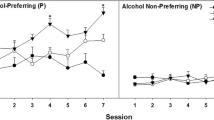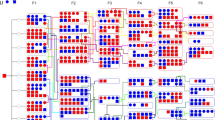Abstract
Ethanol tolerance, a decrease in drug responsiveness with repeated administrations, is an important diagnostic criterion for alcoholism. Rapid tolerance develops within 8–24 hours of an initial ethanol exposure and shares many similarities with chronic tolerance. The genetic contribution to rapid tolerance to ethanol-induced ataxia was estimated using a panel of inbred strains of mice. Strains differed significantly in the degree of rapid tolerance development, which had a broad-sense heritability estimate of 0.11. Artificial selection was carried out to develop lines of mice that would show High (HRT) and Low (LRT) levels of Rapid Tolerance. Starting with HS/Npt mice, derived from a systematic cross of eight inbred strains, a significant response to selection was seen in replicate 1 by the third selection generation. No difference was found in replicate 2. Heritability estimates after the fourth generation were 0.25 for HRT-1 mice and 0.06 for LRT-1 mice. HRT-1 and LRT-1 mice also differed significantly in chronic tolerance development to four doses of ethanol. These studies provide evidence for a genetic contribution to rapid tolerance and support a genetic link between rapid and chronic tolerance to ethanol's ataxic effects.
Similar content being viewed by others
References
American Psychiatric Association (1994). Diagnostic and statistical manual of mental disorders (4th Ed.). Washington, DC: Author.
Barbosa, A. D., and Morato, G. S. (2000). Effect of epipregnanolone and pregnenolone sulfate on chronic tolerance to ethanol. Pharmacol. Biochem. Behav. 67:459-464.
Barbosa, A. D., and Morato, G. S. (2001). Influence of neurosteroids on the development of rapid tolerance to ethanol in mice. Eur. J. Pharmacol. 431:179-188.
Bitrán, M., and Kalant, H. (1993). Effect of anisomycin on the development of rapid tolerance to ethanol-induced motor impairment. Pharmacol. Biochem. Behav. 45:225-228.
Browman, K. E., Rustay, N. R., Nikolaidis, N., Crawshaw, L., and Crabbe, J. C. (2000). Sensitivity and tolerance to ethanol in mouse lines selected for ethanol-induced hypothermia. Pharmacol. Biochem. Behav. 67:821-829.
Crabbe, J. C. (1999). Animal models in neurobehavioral genetics: methods for estimating genetic correlation. In B. C. Jones, and P. Mormède (s.), Neurobehavioral genetics: methods and applications, Boca Raton: CRC Press, pp. 121-138.
Crabbe, J. C., Janowsky, J. S., Young, E. R., Kosobud, A., Stack, J., and Rigter, H. (1982). Tolerance to ethanol hypothermia in inbred mice: genotypic correlations with behavioral responses. Alcohol. Clin. Exp. Res. 6:446-458.
Crabbe, J. C., Kosobud, A., Young, E. R., Tam, B. R., and McSwigan, J. D. (1985). Bidirectional selection for susceptibility to ethanol withdrawal seizures in Mus musculus. Behav. Genet. 15:521-536.
Crabbe, J. C., Phillips, T. J., Kosobud, A., and Belknap, J. K. (1990). Estimation of genetic correlation: interpretation of experiments using selectively bred and inbred animals. Alcohol. Clin. Exp. Res. 14:141-151.
Crabbe, J. C., Rigter, H., Uijlen, J., and Strijbos, C. (1979). Rapid development of tolerance to the hypothermic effect of ethanol in mice. J. Pharmacol. Exp. Ther. 208:128-133.
Erwin, V. G., and Deitrich, R. A. (1996). Genetic selection and characterization of mouse lines for acute functional tolerance to ethanol. J. Pharmacol. Exp. Ther. 279:1310-1317.
Falconer, D. S., and Mackay, T. F. C. (1996). Introduction to quantitative genetics, Essex: Longman Group Ltd.
Gallaher, E. J., Jones, G. E., Belknap, J. K., and Crabbe, J. C. (1996). Identification of genetic markers for initial sensitivity and rapid tolerance to ethanol-induced ataxia using quantitative trait locus analysis in BXD recombinant inbred mice. J. Pharmacol. Exp. Ther. 277:604-612.
Hegmann, J. P., and Possidente, B. (1981). Estimating genetic correlations from inbred strains. Behav. Genet. 11:103-114.
Hitzemann, B., Dains, K., Kanes, S., and Hitzemann, R. (1994). Further studies on the relationship between dopamine cell density and haloperidol-induced catalepsy. J. Pharmacol. Exp. Ther. 271:969-976.
Kalant, H. (1996). Current state of knowledge about the mechanisms of alcohol tolerance. Addict. Biol. 1:133-141.
Kalant, H., LeBlanc, A. E., and Gibbins, R. J. (1971). Tolerance to, and dependence on, some non-opiate psychotropic drugs. Pharmacol. Rev. 23:135-191.
Karcz-Kubicha, M., and Liljequist, S. (1995). Effects of post-ethanol administration of NMDA and non-NMDA receptor antagonists on the development of ethanol tolerance in C57B1 mice. Psychopharmacology (Berl). 120:49-56.
Khanna, J. M., Kalant, H., Chau, A., Shah, G., and Morato, G. S. (1994a). Interaction between N-methyl-D-aspartate (NMDA) and serotonin (5-HT) on ethanol tolerance. Brain Res. Bull. 35:31-35.
Khanna, J. M., Kalant, H., Shah, G., and Chau, A. (1992a). Effect of (+)MK-801 and ketamine on rapid tolerance to ethanol. Brain Res. Bull. 28:311-314.
Khanna, J. M., Kalant, H., Shah, G., and Chau, A. (1993). Effect of D-cycloserine on rapid tolerance to ethanol. Pharmacol. Biochem. Behav. 45:983-986.
Khanna, J. M., Kalant, H., Shah, G., and Weiner, J. (1991). Rapid tolerance as an index of chronic tolerance. Pharmacol. Biochem. Behav. 38:427-432.
Khanna, J. M., Kalant, H., Weiner, J., Chau, A., and Shah, G. (1992b). Ketamine retards chronic but not acute tolerance to ethanol. Pharmacol. Biochem. Behav. 42:347-350.
Khanna, J. M., Kalant, H., Weiner, J., and Shah, G. (1992c). Rapid tolerance and cross-tolerance as predictors of chronic tolerance and cross-tolerance. Pharmacol. Biochem. Behav. 41:355-360.
Khanna, J. M., Morato, G. S., Chau, A., and Shah, G. (1995). Dcycloserine enhances rapid tolerance to ethanol motor incoordination. Pharmacol. Biochem. Behav. 52:609-614.
Khanna, J. M., Morato, G. S., Chau, A., Shah, G., and Kalant, H. (1994b). Effect of NMDA antagonists on rapid and chronic tolerance to ethanol: importance of intoxicated practice. Pharmacol. Biochem. Behav. 48:755-763.
Khanna, J. M., Morato, G. S., and Kalant, H. (2002). Effect of NMDA antagonists, an NMDA agonist, and serotonin depletion on acute tolerance to ethanol. Pharmacol. Biochem. Behav. 72:291-298.
Khanna, J. M., Shah, G., and Chau, A. (1997). Effect of NMDA antagonists on rapid tolerance to ethanol under two different testing paradigms. Pharmacol. Biochem. Behav. 57:693-697.
Lê, A. D., Khanna, J. M., Kalant, H., and LeBlanc, A. E. (1981). Effect of modification of brain serotonin (5-HT), norepinephrine (NE) and dopamine (DA) on ethanol tolerance. Psychopharmacology (Berl). 75:231-235.
Lê, A. D., Mihic, S. J., and Wu, P. H. (1992). Alcohol tolerance. In A. Baker and P. Wu (s.), Animal models of drug addiction, Totowa, NJ: Humana, Press, pp. 95-123.
Ponomarev, I., and Crabbe, J. C. Characterization of acute functional tolerance to the hypnotic effects of ethanol in mice. Alcohol. Clin. Exp. Res. (in press).
Rustay, N. R., Boehm, S. L., 2nd, Schafer, G. L., Browman, K. E., Erwin, V. G., and Crabbe, J. C. (2001). Sensitivity and tolerance to ethanol-induced incoordination and hypothermia in HAFT and LAFT mice. Pharmacol. Biochem. Behav. 70:167-174.
Rustay, N. R., Wahlsten, D., and Crabbe, J. C. (2003). Influence of task parameters on rotarod performance and sensitivity to ethanol in mice. Behav. Brain Res. 141:237-249.
Wu, P. H., Mihic, S. J., Liu, J. F., Le, A. D., and Kalant, H. (1993). Blockade of chronic tolerance to ethanol by the NMDA antagonist, (+)-MK-801. Eur. J. Pharmacol. 231:157-164.
Zaleski, M. J., Nunes Filho, J. R., Lemos, T., and Morato, G. S. (2001). GABA(B) receptors play a role in the development of tolerance to ethanol in mice. Psychopharmacology (Berl). 153:415-424.
Author information
Authors and Affiliations
Rights and permissions
About this article
Cite this article
Rustay, N.R., Crabbe, J.C. Genetic Analysis of Rapid Tolerance to Ethanol's Incoordinating Effects in Mice: Inbred Strains and Artificial Selection. Behav Genet 34, 441–451 (2004). https://doi.org/10.1023/B:BEGE.0000023649.60539.dd
Issue Date:
DOI: https://doi.org/10.1023/B:BEGE.0000023649.60539.dd




